Japanese aerial cameras
Contents
Machine-gun training cameras

|
| Top: Katsura Seisakusho Machine Gun Training Camera bottom: Rokuoh Sha Type 89 Machine Gun Training Camera image by Dirk HR Spennemann (Image rights) |
Machine-gun training cameras are shaped as a machine gun, and are used to train the gunners. Rokuoh-sha made various such cameras from the mid-1920s onwards, and Tōkyō Kōgaku made at least one model in the late 1930s. These "machine guns" shot photos of targets instead of shooting bullets onto the targets for documentation of a new machine gunner's training success.
The Type 15 Gun Camera with Watch (一五式写真銃時計附)[1][2] was made by Rokuoh-sha for the Navy, and the Type 15 Gun Camera Modified 1 (一五式写真銃改一)[3] was certainly an evolution.
This machine-gun camera was ordered in May 1925 by Yamada Kōgorō (山田幸五郎) of the Japanese Navy, was produced from 1926 under the supervision of Mōri Hirō (毛利広雄), and delivered from 1927.[3] It was inspired by the Hythe gun camera made by Thornton-Pickard in Great-Britain from 1915,[1][3] itself based on the Lewis machine gun. The Japanese copy was initially equipped with Wollensak or Zeiss Tessar lenses.[3] It is said that it was produced until 1942,[3] certainly switching to Japanese lenses at some point.
The camera takes 120 size rollfilm, and reportedly makes 4×4.5cm exposures, with target rings superimposed on the image.[1] The time is recorded on the rest of the 6×6cm frame[1] via a secondary lens on the side, taking pictures of a watch dial placed under the front bead. The camera has no sequential firing ability, and the frames are advanced by a spring motor one by one.[2] The gun camera normally has a drum magazine at the top, only used to enhance the similarity with the Lewis machine gun.[2]
Army Revolving Target-checking Camera
The Revolving Target-checking Camera (廻転式射撃鑑査写真機) was a similar camera made by Rokuoh-sha for the Army.[4][3] (In the name, the word "revolving" either refers to the drum magazine mounted at the top or to the fact that the camera was mounted on a turret.) The camera was also called "Hythe type" (ハイス型),[5] after the original Hythe gun camera of which it was a copy.[6]
This model was perhaps released around 1926, at the same time as the Type 15 for the Navy. The image size is 4.5×6cm on 120 film,[4] and there is no time recording device. It is said that the early cameras have Wollensak or Zeiss Tessar lenses.[3] Later ones have an Optor 28.5cm f/11 lens.[4][7]
The same camera was also made by Tōkyō Kōgaku, which supplied 605 units to the Japanese Army.[8] The version made by this company is called "Model 17" in some recent sources, but this is perhaps a confusion with the serial number of a surviving camera.[9] One source mentions a 387.5mm f/11 fixed-focus lens, but the focal length is perhaps wrong.[10]
The Type 89 Moving-image Machine-gun Camera (八九式活動写真銃) was an all new model by Rokuoh-sha. It is said that four experimental cameras were made in 1929.[3] (In the name, "Type 89" stands for year 2589 in the Japanese mythological calendar, i.e. 1929.) That early version perhaps had imported lenses. The improved Type 89 Moving-image Machine-gun Camera Kai (八九式活動写真銃改) or "Kai 1" (改一) followed in 1931 with Hexar lenses.[3] The final version was the Kai 2 (改二), serial produced from 1933 to about 1944.[3] The camera was used by the Navy,[11] as indicated by the anchor usually stamped on the nameplate.[12]
The production figures for the 1941–1945 period were as follows:[13]
| Year | 1941 | 1942 | 1943 | 1944 | 1945 | Total |
| Ordered | 1320 | 1500 | 600 | — | — | 3420 |
| Delivered | 941 | 1506 | — | — | — | 2447 |
The camera takes 18×24mm target pictures through the main lens and the time measured by a Seikosha stop watch through an auxiliary lens.[11] on 35mm cine film loaded in 2.5m strips.[14][15] It is driven by a spring motor, and can take sequences at 10 frames per second.[11] The taking lens is a Hexar Ser.1 7.5cm f/4.5, and the firing time is recorded via a Hexar Ser.1 4cm f/4.5 auxiliary lens aimed at a stop watch dial.[3][11] The optical sight, handgrip and attachment lugs are removable, and minor variations may exist.[16]

|
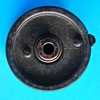 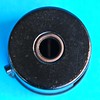  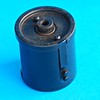 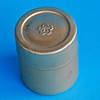 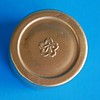
|
| Film cassette for the Type 89 Machine-gun Camera. Pictures by Dirk HR Spennemann. (Image rights) |
Katsura Seisakusho Machine Gun Training Camera
Katsura, the maker of aerial cameras, made another machine gun training camera. It was almost shaped like a light Japanese type 92 machine gun for calibre 7.7mm. (see pinterest museum picture and WWII picture)
- ↑ 1.0 1.1 1.2 1.3 Sugiyama, item 6014.
- ↑ 2.0 2.1 2.2 Nakayama and Imai, pp.126–7 of Militarī gun'yō kamera daizukan.
- ↑ 3.00 3.01 3.02 3.03 3.04 3.05 3.06 3.07 3.08 3.09 3.10 This page at R.Konishi Rokuoh-sha. Cite error: Invalid
<ref>tag; name "hexar0" defined multiple times with different content - ↑ 4.0 4.1 4.2 Sugiyama, item 6018.
- ↑ Label inside the original box, observed in a picture posted at a forum.
- ↑ Iwama, p.54 of Kurashikku Kamera Senka no.10, mentions a "Hythe model Target-checking Camera" (ハイス型射撃鑑査写真機) for the Navy. This is probably a confusion between the Army's Revolving Target-checking Camera and the Navy's Type 15 Gun Camera.
- ↑ Example pictured in this page at Seawood Photo.
- ↑ Sugiyama, item 6016.
- ↑ The camera is called "Model 17" in Sugiyama, item 6016, but the Japanese text actually corresponds to a serial number (第十七号), certainly that of the pictured example. Antonetto and Russo, pp.25 and 196, repeat the name "model 17", certainly after Sugiyama; they say that this was a "rapid-firing camera capable of shooting a burst of 4.5×6cm frames", but this is unconfirmed.
- ↑ Antonetto and Russo, p.196.
- ↑ 11.0 11.1 11.2 11.3 Sugiyama, item 6015.
- ↑ Many of these cameras were acquired by U.S. soldiers in Japan and consequently they are quite frequently offered in on-line auctions
- ↑ Cite error: Invalid
<ref>tag; no text was provided for refs namedJNP p8 - ↑ Iwama, p.54 of Kurashikku Kamera Senka no.10.
- ↑ Seikosha stop watch from a Type 89 machine gun camera on uhrforum [1]
- ↑ Minor variations are reported between the two examples pictured in Nakayama and Imai, pp.124–5 of Militarī gun'yō kamera daizukan.